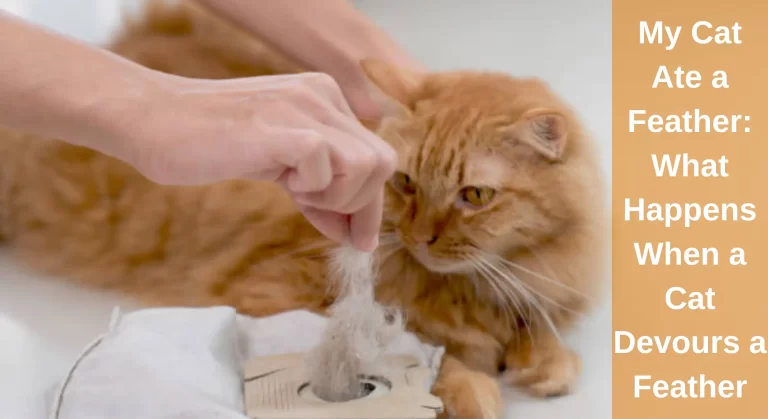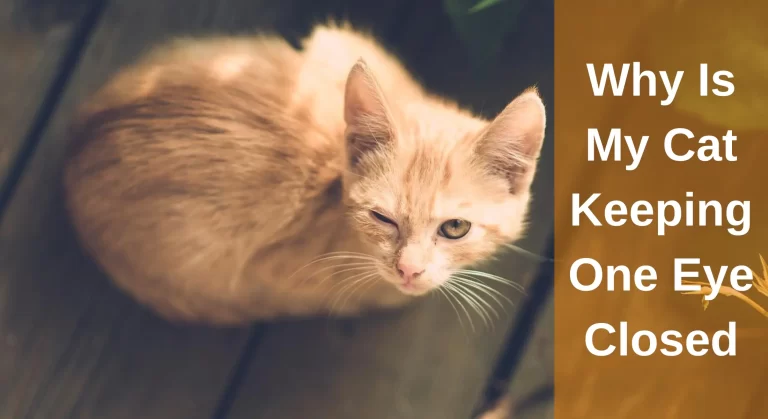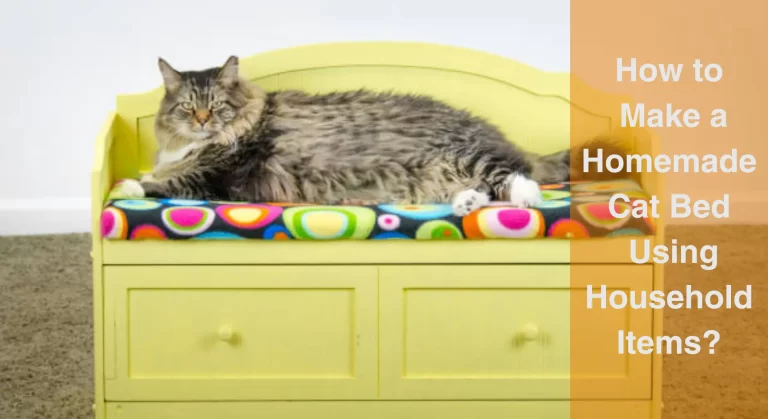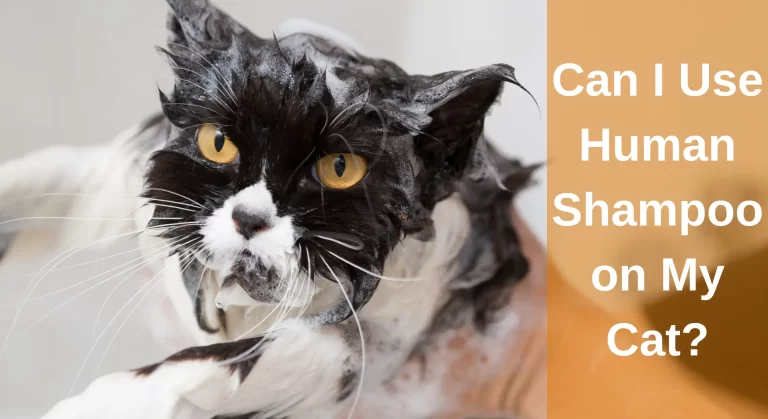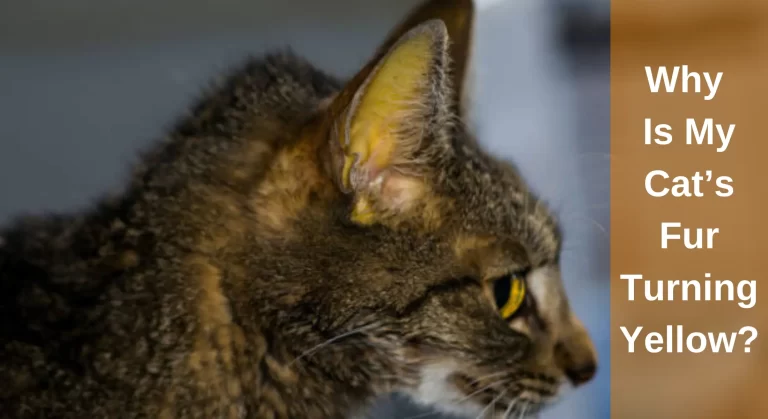Is It Necessary To Trim A Cat’s Claws? All You Need To Know
It is common for cats to use their nails for a variety of functions, including climbing, scratching, and marking territory. It’s interesting to note that cats have retractable nails that stay hidden until they’re needed. Cats that spend most of their time outdoors climb trees and scratch them to keep their nails short. Many indoor cats use scratching posts to keep their nails short, but the posts cannot keep the nails short indefinitely.
Many cat owners frequently ask this question, “Is it necessary to trim a cat’s claws?”.
Yes. The nails of indoor and outdoor cats should be trimmed regularly because overgrown, curved nails can cause significant pain and make it difficult for them to move around. A cat’s nails should be trimmed every 10 days or two weeks to prevent this from happening. Your cat’s nails should also be kept short for health reasons.
Trimming your cat’s nails can be stressful for both you and your pet, but with a few simple tips, the process can be enjoyable and relaxing for both of you.
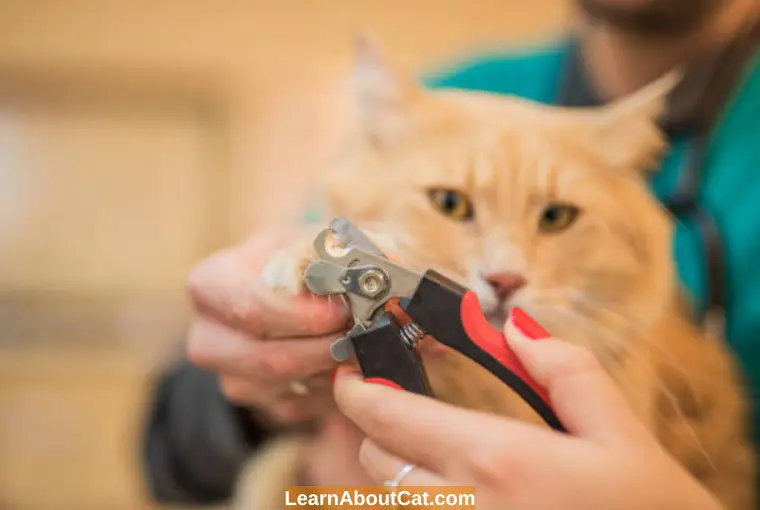
Why Should I Cut My Cat’s Nails?
Cat nails that are too long might be dangerous for several reasons.
First off, it could harm and discomfort them. Second, they’ll try to use your carpet, sofa, bookcase, and other furniture in your home—basically everything they can get their hands on—to file their nails down.
Keeping your cat’s nails short will help prevent them from becoming too long and causing these issues. Following are the justifications for cat nail trimming in greater detail.
Find Out: Can Cat Paw Pads Change Color?
1. Lowers the Possibility of Furniture Damage
Cats like to scratch as it’s their natural behavior. It is more worrisome if they abruptly stop scratching.
Cats produce sweat as they scratch, which drips from their paws, slides down their claws, and settles on the object they are scratching, leaving their scent behind. Cats mark their territory in this manner. Some cats could scratch something out of curiosity since doing so will provide them with knowledge. When stressed or feeling vulnerable, cats usually scratch more.
Due to the pain and suffering that having long nails may cause, cats also scratch to help file them down and keep them at a reasonable length. Therefore, by regularly trimming your cat’s claws, you are probably reducing both the frequency of their scratching activities and the damage they do.
2. For the Additional Comfort of Your Cat
Your first duty as a cat owner should be to maintain your cat’s happiness and health. If you let your cat’s claws grow out too far, they can end up hurting your pet more than helping it. A cat’s claws grow similarly to human fingernails and toenails throughout time.
It is simple for a cat’s claws to grasp onto food, predators, the ground, or anything they are climbing because of the peculiar curvature of their nails. However, overly long nails can be uncomfortable and difficult to retract when walking on them.
3. Reduces the Risk of Owners Suffering harm
The least chance of injury to you as the owner is the final solid reason to trim your cat’s nails.
Play is essential for building a deep bond with your cat and for encouraging them to exercise so they may be happy and healthy. In the wild, cats hunt similarly to how they play, which regrettably implies that claws may be extended, and there is a possibility that they may accidentally scratch you.
Find Out: Why Are My Cat’s Nails Splitting?
Do I Need To Trim My Cat’s Nails? What Happens If Your Cat’s Nails Aren’t Trimmed?
Claws are essential for a cat’s survival. Even indoor-only domestic cats need their claws for play, climbing, balancing, and grooming. In the wild, cats require their claws to seek and catch prey. Does leaving them long truly be an issue, considering how much cats depend on their claws?

As a cat owner, I had to discover the importance of clipping your cat’s nails hard. Long claws have the ability to grow into your cat’s paw pads and coil back on themselves, which may be quite unpleasant for them.
Keeping your cat’s nails clipped will also help you prevent accidents and damage to your furniture. This article covers quick cat claw-trimming techniques and other ways to help cats file their nails down.
Also Read: Overgrown Cat Claws: Do Overgrow Nails Hurt Cats?
When Do Cats’ Nails be Cut?
Keep an eye out for any signs of injuries, swelling, infection, damage, or splinters on your cat’s paws and nails on a regular basis. If your cat’s nails are still short, you can postpone trims every 10–14 days for a little while.
If you can hear your little friend’s toes tripping over each other as their nails tap on the floor, it’s time for a nail clip.
How to Trim Cat Nails? Tips
Nail trimming also eliminates behavioural and health problems associated with declawing, which entails surgery.
A cat’s claws can be tricky to trim, so if you are afraid to do it, keep in mind that practising until you get the hang of it will help you become a more skilled cat claw trimmer.
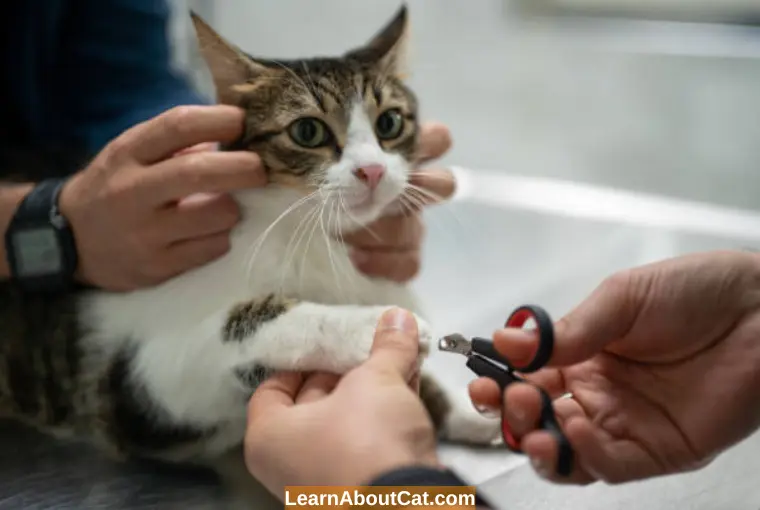
1. Choose the Proper Time and Setting
It’s best to start clipping your cat’s nails when they are still kittens so they become used to it. When you’re prepared to begin, choose a quiet area away from noise sources where you can cut your cat’s nails without being distracted.
Trim your cat’s nails when they are dozing off or just after a hearty meal to ensure the greatest mood possible. Make some food, let your cat sit on your lap, and treat them well.
2. Set the Cutting Parameters
Once your cat is comfortable and on your lap, you can lift up one of its paws, but be careful not to startle your furry pet too much. Insert your fingertips between a toe pad. For the greatest results when trimming a cat’s nails, it helps to take a closer look at the anatomy of claws. You should be able to tell between the three following crucial parts:
- Cats frequently remove the sheath or outer coating.
- The speedy inner “pink” region is made up of neurons and blood vessels.
- The sharp bit and the claw are both well-known to us all.
Avoid cutting into the quick, pink region that is home to nerves and blood vessels. Cut away from the pink area to keep your cat’s wound from bleeding and becoming infected. Instead of risking the possibility of cutting them too near to the bone, it is advisable to trim them slightly.
3. Make Friends With the Paw
Release your cat’s paw after delicately clipping the tip of one nail, and as a reward, give them a treat. You can remove a few more nails if your cat doesn’t appear to be incensed. The best you can expect for some cats is a daily nail trim.
If your cat is unhappy or furious, don’t try to trim its nails. Similarly to this, if your cat is not engaging, try another time again or seek professional guidance rather than becoming angry or reprimanding them.
The smoother the nail will be after being cut, the sharper the clippers. You may file the nail down after you’ve trimmed your cat’s nails to stop it from snagging.
4. Embrace Your Kitty
Following cutting, give your cat a treat, their preferred cat food, or plenty of caressing and soothing words. If you use that method, your cat may even begin to accept the nail-cutting operation.
5. Repeat the Process
Since most cats dislike clipping their nails, you might need to repeat these steps daily until you’ve removed all of your cat’s toenails. Always be patient, compliment your cat on good behaviour, and try to make the experience as comfortable as you can for both of you.
Things to Avoid
- It is important not to rush a nail trim, as nicking quickly can result in severe complications.
- Do not attempt to trim your cat’s nails when they are upset or when you are in a bad mood because this will make the process more difficult.
- Whenever your cat resists, don’t punish it. This will only cause your cat to become more resistant in the future.
- Your cat’s nails should not all be trimmed at once
How Can I Ensure the Health of My Cat’s Nails?
While you should cut your cat’s nails, you also want to keep them healthy. Scratching, playing, and other activities cause wild cats to wear their nails down rather than cut them naturally. You may take a few simple actions to keep your cat’s nails healthy and tidy at home.

1. Purchase a Cat Tree
Cat trees and cat scratching posts are similar. Cat trees have several posts, platforms, and boxes but are made of the same material as a single scratching post. This provides your cat with something to scratch, climb, and hide in, which they will adore.
Due to the multiple uses of cat trees, you could find that your cat chooses to use them as a scratching post instead. Your cat’s nails will be better filed if you use the item more frequently. However, not every cat or every environment is a good fit for cat trees.
2. Buy a Scratching Post for Your Cat
A cat scratching post is necessary for all cat owners. These products are often made of sisal, although rarely, they may also include real wood. When your cat scratches, sisal and wood effectively file its claws since they are both fairly robust. If money is limited, another option would be to purchase cardboard scratching posts, but they aren’t as durable and aren’t really a long-term solution unless you want to replace them constantly.
Check Out: How to Stop Cats from Scratching Leather Furniture?
3. Maintain a Healthy Weight
Wild cats maintain good nails via hunting, movement or playing. Cats with a healthy weight are more likely to desire to exercise, but cats that are overweight or obese won’t want to spend as much time standing around since they will tyre out more quickly. Consequently, keeping your cat at a healthy weight might significantly help keep its claws in good shape.
Should I Cut My Cats Claws?
In order to maintain your pet’s health, your cat’s claws should be trimmed every two to three weeks. In addition to protecting you, your pets and your family, a quick trim can also save your furniture such as the sofa, curtains, and others.
Should I Remove My Cats Claws?
Instead of cutting their cat’s claws periodically and trying to keep them short, some cat owners wonder if it is possible to permanently remove the nails from their cat. Another word for this is declawing. Don’t try to trim your cat’s nails, no matter how desperate you are. Both extremely long claws and total cat declawing might harm your pet.
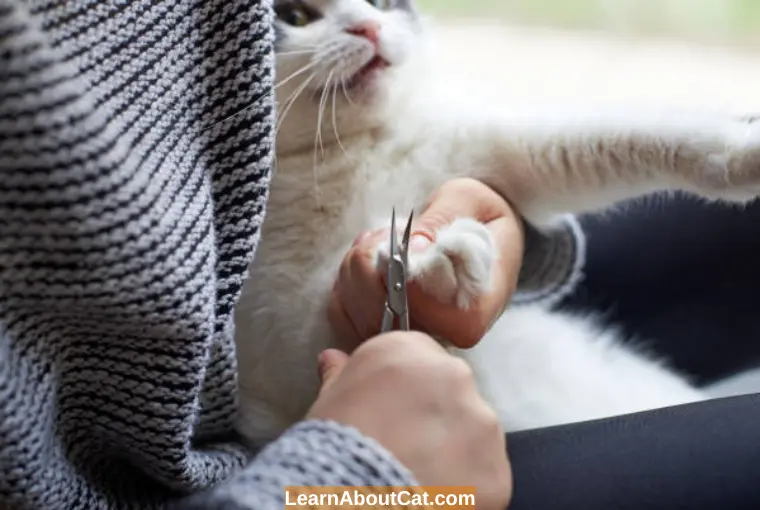
The way your cat’s feet contact the ground changes after its claws are removed, and suddenly, parts of its paws that never normally touch the floor may do so.
Your cat may find it challenging to walk and move about, much the same way you would if you constantly wear uncomfortable shoes.
Additionally, because claws are not designed to be removed, they usually try to grow back following surgery. This may injure the nerves in addition to producing agonizing anguish. Because of the risk of infection from the surgical wounds, even using their litter box might harm their paws. Therefore, amputating your cat’s claws won’t be a good replacement for regular nail care and will result in a lot more issues.
Frequently Asked Questions
What should I do if I inadvertently cut my cat’s nail too short and it bleeds?
Remain calm if you accidentally cut your cat’s nail too short and it begins to bleed. Use a cauterising powder, silver nitrate stick or styptic powder to halt the bleeding. The bleeding could be stopped as a last resort by adding baking soda, flour, or a bar of soap. In any case, take your pet to the doctor to treat the wound appropriately.
Does nail clipping apply to all felines?
You might be wondering if cat nail clipping is necessary for all cats. The truth is that by neglecting to trim their cat’s nails, owners do not consider the aforementioned issues, such as your cat’s misery, damaged furniture, and a higher chance of harm to the owner. The overly long nails of cats cause them.
Most cats, particularly those that live outside, don’t need their nails trimmed. However, indoor cats, cats with arthritis, and senior cats can all benefit from routine nail cutting since they don’t receive as much exercise for natural nail filing as outdoor cats do. Ask your veterinarian if you’re unclear about trimming your cat’s nails.
How do cats trim their own nails?
Cats groom their claws by removing the outer sheath that covers the nail. The cat may choose to do this by scratching its nails against an indoor scratching post, a tree (if an outdoor cat), or by chewing in order to expose the new claw.
Do indoor cats need their nails trimmed?
Yes, it is important to keep the nails trimmed of indoor cats, as the cat’s nails can catch on soft surfaces and be snagged, or their claws may become incapable of retracting. When arthritis affects a cat, scratching keeps their nails short. But many arthritis cats don’t bother to do this because they are too inactive to do it
Final Thoughts!
Overgrown claws may be uncomfortable for your cat, dangerous for you, and more harmful to your belongings, so it’s crucial to keep them at a healthy length. If you see that your cat’s nails are getting too long, you should trim them.
Using my tried-and-true approach, cats will ultimately become accustomed to having their nails cut and come to like the process, even if they first loathe it. Giving your cat plenty of toys, cat trees, scratching posts, and playtime will also help keep its claws healthy without the need to trim them.
Declawing your cat is never the proper decision, and it will only make matters worse, no matter how desperate you are.
Who is Isabella?
My name is Isabella, and I am a dedicated and knowledgeable cat enthusiast. With years of experience caring for cats and a deep love for felines, I made a mission to help other cat lovers navigate the challenges of cat ownership.


